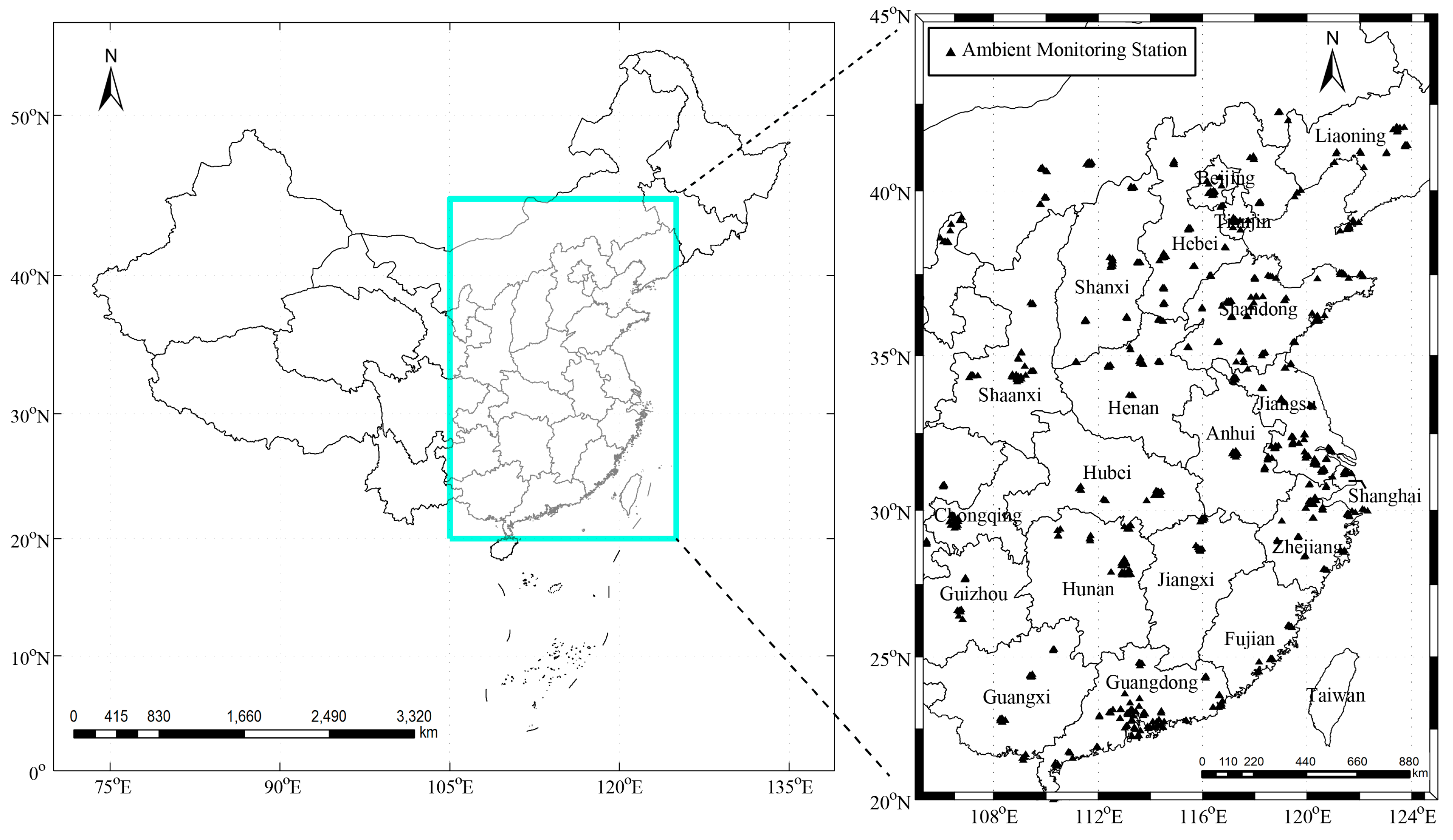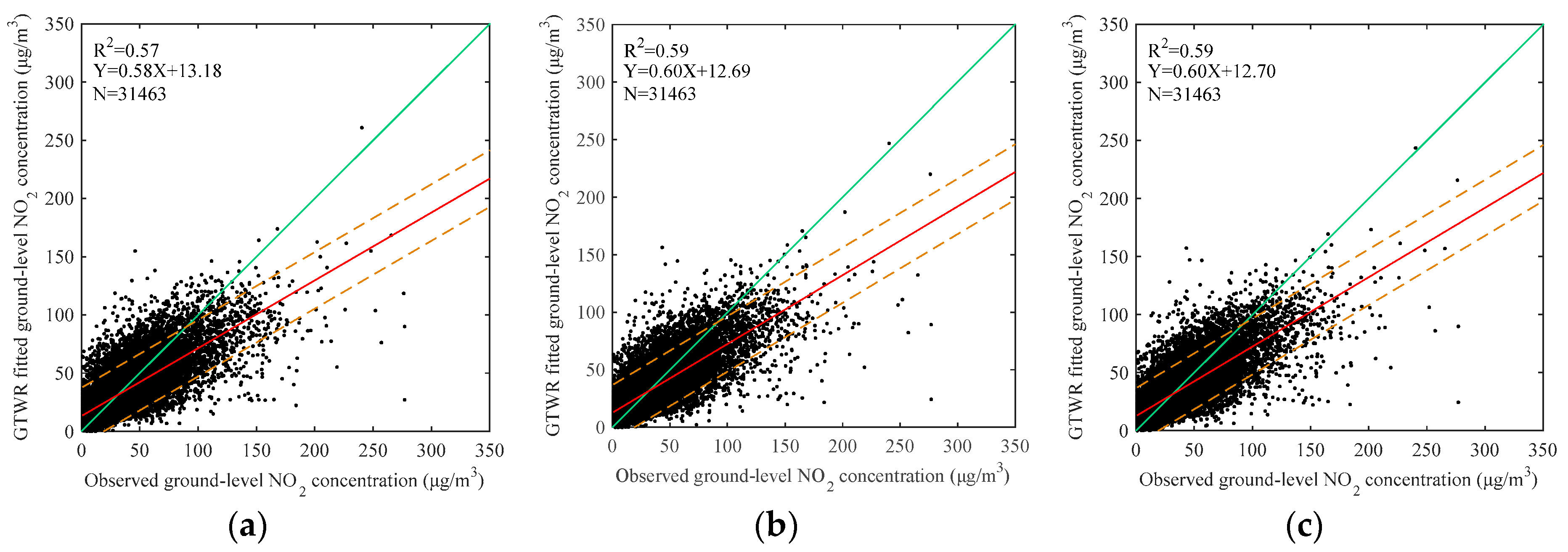4.1. Spatio-Temporal Non-Stationarities between Tropospheric-Columnar and Ground Level NO2
According to previous studies [
43,
44], the tropospheric NO
2 profiles show a large spatial-temporal variation. It is necessary to assess the impact of the spatio-temporal non-stationarities on the satellite-estimated ground level NO
2 concentrations. Lamsal et al. [
38] showed that OMI retrievals are underestimated in urban regions and overestimated in remote areas about 20%. To isolate the influence of different land covers types, 293 pure urban grids and corresponding ambient stations were picked out from the total 509 grids and stations. As shown in
Figure 3a, the mean values of tropospheric-columnar and corresponding ground level NO
2 over three provinces in eastern China (see also
Figure 1) i.e., Shandong, Zhejiang, and Hunan, are compared. The mean values of OMI tropospheric NO
2 columns of the three provinces are different when the column data is composited with respect to the ground level NO
2 mass concentrations from ambient monitoring stations. This is related to the spatial difference in tropospheric NO
2 profiles due to different topographies and meteorological conditions. Moreover, the mean values of OMI tropospheric NO
2 columns in summer (May to July 2013), autumn (August to October 2013), winter (November 2013 to January 2014), and spring (February to April 2014) are compared in
Figure 3b. The relationship between the NO
2 columns and ground level NO
2 shows a significant seasonal variation. The NO
2 columns in winter and autumn are higher than those in summer and spring when the values of ground level NO
2 are at the same level. This seasonal difference is more notable when ground concentrations increase, which is likely because of the longer lifetime of NO
2 in winter and autumn as compared to that in summer and spring. Consequently, it can exist for a longer time in the upper layer in the case of high ground emissions. The numbers of satellite observations used in
Figure 3a,b are given in
Table 2 and
Table 3, respectively. It should be pointed out that the numbers of satellite observations for high ground level NO
2 (>100 μg/m
3) are less than five in Hunan and in summer.
4.2. Comparison between Model Fitted and Ground-Observed NO2
The ordinary least squares (OLS), GWR, temporally weighted regression (TWR), and GTWR models were tested using the same datasets. As shown in
Table 4 and
Table 5, the OLS performance reveals that the tropospheric NO
2 columns are potentially useful for ground level NO
2 with R
2 of 0.45 and 0.44 for fitting and validation, respectively. The TWR outperforms the GWR with significant increases of R
2 values from 0.55 and 0.49 to 0.61 and 0.55. This suggests that the temporal non-stationarity is more dominant than the spatial non-stationarity between the tropospheric NO
2 columns and ground level NO
2. Among the four models, the GTWR has the best performance in both model-fitting and cross-validation with the highest R
2 and lowest errors (RMSE, MAD, and MAPE). Nevertheless, the GTWR regression shows a slight over-fitting, i.e., the R
2 generated from the cross-validation is 0.09 smaller than that from the model-fitting. In addition, the scatter plots in
Figure 4 shows the largest correlation slope and the smallest intercept for the GTWR model. It is worth noting that all of the regression line slopes for the four models are less than 1.
Figure 5 is present to assess the impact of the numbers of valid observations on the GTWR performance. The R
2 over Hunan (
Figure 5a) is smaller than those over Shandong (
Figure 5b) and Zhejiang (
Figure 5c), due to less observations.
There are three possible errors in the estimation of ground level NO
2 concentrations using the satellite-based GTWR model. First, satellite data are collected over an area of hundreds of km
2, while in-situ measurements are point observations. Second, the errors in the retrieval of OMI tropospheric NO
2 columns are underestimated in urban regions and overestimated in remote areas by about −20% and 20%, respectively [
38]. Third, the uncertainty in the meteorological parameters can affect the vertical distribution of tropospheric NO
2. Zhang et al. [
45] validated the NCEP FNL data against meteorological station data over Henan, China during 2012, and they found the errors of air temperature and pressure are −3~2 K and −10~10 hPa, respectively. We introduced the expected random errors (Gaussian distribution) from the tropospheric NO
2 columns, air temperature, and air pressure, to assess their impact on the performance of the GTWR model. As shown in
Table 6 and
Figure 6, our model uncertainties are relatively low with the expected uncertainties from the model parameters.
In the GTWR model, the smaller the spatio-temporal distance between two samples is, the greater weight coefficients are given. As illustrated in
Figure 7, the GTWR performs much better than the OLS for the samples whose distances to the ambient monitoring stations are within 100 km, whereas the GTWR performance is worse than the OLS (0.41 versus 0.44 for R
2) for the samples that are more than 100 km away from the ambient monitoring stations. In the regions like Anhui, Jiangxi, and Fujian, where the ambient monitoring stations are very sparse and unevenly distributed, the nearest samples are mostly more than 100 km away. Hence, we used adjustable bandwidths according to the sample distances rather than the fixed ones. As compared to
Figure 7, the R
2 in
Figure 8 improves from 0.41 to 0.50 for the samples with larger distances (>100 km) after adjusting the bandwidth.
To compare the GTWR method with the chemistry transport model (CTM) approach, we generated the tropospheric NO
2 profiles by using a WRF-Chem model with the monthly MIX Asian anthropogenic emission inventory [
46]. This emission inventory has a spatial resolution of 0.25 × 0.25° and involves four emission categories, including industry, power, transport, and residential. The model has 20 vertical levels and the top level pressure is 200 hPa. The RADM2 chemical mechanism is used for the gas-phase chemical reaction calculations. The Modal Aerosol Dynamics Model for Europe-MADE/SORGAM is chosen for the aerosol scheme. Then, we estimated the ground level NO
2 concentrations in January 2014 over central-eastern China using the approach described by Lamsal et al. [
18,
19]. As shown in
Figure 9, the result of the GTWR fitted is much better than the WRF-Chem. Recently, Gu et al. [
43] estimated the ground level NO
2 over China using the chemistry transport model approach with the Community Multi-scale Air Quality (CMAQ) model by considering the influence of China’s high atmospheric pollution on obtaining the vertical distribution of tropospheric NO
2 profiles. They achieved a correlation coefficient (R) of 0.80 for January 2014, which is comparable to the coefficient of determination (R
2) of 0.60 obtained by the GTWR.
To further evaluate the performance of the GTWR model, the comparison of the annual mean of NO
2 concentrations between the model-fitted and ground-observed data is given in
Figure 10. Overall, the NO
2 concentrations estimated by the GTWR model agree well with the ground-based measurements. More than 90% of the cross-validation stations possess low mean discrepancies of less than 10 μg/m
3.
4.3. Spatial Distribution of GTWR Fitted Ground-Observed NO2
The spatial distributions of annual mean NO
2 values are shown in
Figure 11. The fitted ground-observed NO
2 concentrations by GTWR in (a) have similar spatial patterns to the satellite tropospheric NO
2 columns in (b). The concentrations are comparable to the interpolated in situ observations using the Kriging method in (c) over the region with high values. Importantly, in the areas without monitoring stations (e.g., southern Jiangxi and northern Fujian),
Figure 11a provides more reasonable estimations that are overestimated in
Figure 11c. In
Figure 11a, high NO
2 concentrations are clustered in the regions of North China Plain, Yangtze River Delta, and Pearl River Delta. Especially, the NO
2 concentrations in southern Hebei, northern Henan, central Shandong, and southern Shaanxi exceeded the Level 2 standard of the Chinese National Ambient Air Quality Standard (40 μg/m
3).
Figure 12 denotes dramatic seasonal changes in the spatial distribution of GTWR fitted ground level NO
2. Unparalleled high values are found in winter, while the lowest values are found in summer.
4.4. Population-Weighted Ground Level NO2 Concentrations
Given the NO
2 toxicity to human health, it is necessary to evaluate population exposure levels over different provinces. Traditionally, the province-level mean NO
2 concentration provided by the Chinese environmental protection agencies are the arithmetic means of all values in administered cities. Here, we calculated the annual mean population-weighted NO
2 (AMPNO
2) concentrations by using Equation (20). The annual mean NO
2 concentrations (AMNO
2) and AMPNO
2 of 17 provinces in central-eastern China are summarized in
Table 7. AMPNO2 is higher than AMNO2 for all of the provinces, especially for densely populated provinces, e.g., Hebei, Beijing, and Guangdong. People from these 17 provinces except Anhui, Fujian, Jiangxi, and Hunan, are exposed to high-level NO
2 concentrations (>30 μg/m
3). Heibei, Tianjin, and Beijing suffer from the most serious NO
2 pollution, with more than 70% of people affected by high-level NO
2. The satellite-estimated ground level NO
2 concentration is observed at afternoon (13:00–15:00) leading to underestimated annual mean values.



















